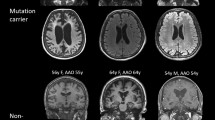Abstract
We report duplication of the APP locus on chromosome 21 in five families with autosomal dominant early-onset Alzheimer disease (ADEOAD) and cerebral amyloid angiopathy (CAA). Among these families, the duplicated segments had a minimal size ranging from 0.58 to 6.37 Mb. Brains from individuals with APP duplication showed abundant parenchymal and vascular deposits of amyloid-β peptides. Duplication of the APP locus, resulting in accumulation of amyloid-β peptides, causes ADEOAD with CAA.
This is a preview of subscription content, access via your institution
Access options
Subscribe to this journal
Receive 12 print issues and online access
$209.00 per year
only $17.42 per issue
Buy this article
- Purchase on SpringerLink
- Instant access to full article PDF
Prices may be subject to local taxes which are calculated during checkout


Similar content being viewed by others
References
Tanzi, R.E. et al. Cell 120, 545–555 (2005).
Vonsattel, J.P. et al. Ann. Neurol. 30, 637–649 (1991).
Tournier, I. et al. Cancer Res. 64, 8143–8147 (2004).
Raux, G. et al. J. Med. Genet. 42, 793–795 (2005).
Rahmani, Z. et al. Proc. Natl. Acad. Sci. USA 86, 5958–5962 (1989).
Sharp, A.J. et al. Am. J. Hum. Genet. 77, 78–88 (2005).
Hattori, M. et al. Nature 405, 311–319 (2000).
Jackson, J.F. et al. Clin. Genet. 9, 483–487 (1976).
Braak, H. et al. Acta Neuropathol. (Berl.) 82, 239–259 (1991).
Mirra, S.S. et al. Neurology 41, 479–486 (1991).
Tapiola, T. et al. Neurology 56, 979–980 (2001).
Oyama, F. et al. J. Neurochem. 62, 1062–1066 (1994).
Prasher, V.P. et al. Ann. Neurol. 43, 380–382 (1998).
Delabar, J.M. et al. Science 235, 1390–1392 (1987).
Singleton, A.B. et al. Science 302, 841 (2003).
Acknowledgements
We thank A. Rossi, C. De La Rochebrochard and H. Moirot for cytogenetic materials, C. Duyckaerts and F. Letournel for brain tissue samples, F. Checler for antibodies to Aβ, J. Bou for technical assistance, A. Goldenberg, S. Jacquemont, E. De La Fournière, T. Dutoya, C. Thomas-Anterion and F. Pasquier for clinical evaluation of patients and M. Tosi for critical reading of the manuscript. A.R.-L. was supported by le Conseil Regional de Haute Normandie.
Author information
Authors and Affiliations
Corresponding author
Ethics declarations
Competing interests
The authors declare no competing financial interests.
Supplementary information
Supplementary Fig. 1
QF-PCR analysis. (PDF 596 kb)
Rights and permissions
About this article
Cite this article
Rovelet-Lecrux, A., Hannequin, D., Raux, G. et al. APP locus duplication causes autosomal dominant early-onset Alzheimer disease with cerebral amyloid angiopathy. Nat Genet 38, 24–26 (2006). https://doi.org/10.1038/ng1718
Received:
Accepted:
Published:
Issue Date:
DOI: https://doi.org/10.1038/ng1718
This article is cited by
-
Histone deacetylase inhibitors VPA and WT161 ameliorate the pathological features and cognitive impairments of the APP/PS1 Alzheimer’s disease mouse model by regulating the expression of APP secretases
Alzheimer's Research & Therapy (2024)
-
The advent of Alzheimer treatments will change the trajectory of human aging
Nature Aging (2024)
-
Cerebral organoids with chromosome 21 trisomy secrete Alzheimer’s disease-related soluble aggregates detectable by single-molecule-fluorescence and super-resolution microscopy
Molecular Psychiatry (2024)
-
Proteomic analysis across patient iPSC-based models and human post-mortem hippocampal tissue reveals early cellular dysfunction and progression of Alzheimer’s disease pathogenesis
Acta Neuropathologica Communications (2023)
-
Cathepsin B abundance, activity and microglial localisation in Alzheimer’s disease-Down syndrome and early onset Alzheimer’s disease; the role of elevated cystatin B
Acta Neuropathologica Communications (2023)



